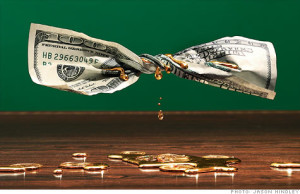Do you have an emergency fund? Is it large enough? When do you tap into it and how is it re-supplied?
I ask these questions because, as I remarked in my book, “In all the years that I have practiced, I can safely say that less than 5 percent (probably less than 1 percent) of the people I have counseled had adequate cash reserves.”
Various causes have been proposed for this problem:
- Not making enough to save
- Lacking discipline
- Tried without success
Considering how many people really desire to save, finding an explanation as to why they DO NOT is key to solving many financial planning problems.
Again from my book: “After thinking on this for a while, counseling numerous clients and meditating on my own experiences, I believe the answer to this conundrum can be found in the way that the public views the concept of saving. And what is that view? In a word: Futile.”
How many times have you tried saving, built up a nice stockpile only to have it decimated by a series of emergencies (good reason), a “great deal” that your spouse found, the IRS or a series of fast food runs (all bad reasons)?!? It is my contention that anytime a saver sees their hard-earned, emergency reserve go up in smoke, a sense comes upon them that says, “What’s the use?” And, in point of fact, I agree.
Which is why I argue that people should implement a concept called emergency funding rather than trying to build an “emergency fund.” Emergency funding is a PROCESS whereby money is stored, used and replenished on a regular basis. It also requires the additional process of “being your own banker“. Though “emergency funding” and “emergency fund” sound similar, they could not be more different. An emergency fund is that static, rarely achieved and futility-inducing dream-state mentioned above. Emergency funding is a dynamic process that establishes a discipline, encourages saving and increases efficiency and the likelihood of success.
Or, as Robert Castiglione said in his book, “Although none of us has the financial power of a bank…you can use the same principles to make your money work more productively, efficiently and effectively….Only when money stays in motion, being put to several different uses and flowing through your personal financial model like blood through your body, will you have successful results.” [Emphasis added]
Emergency funding is all about creating that process whereby your money “stays in motion,” is put to “different uses” and “flows” through your “personal financial model.” Start doing that today and you will never again feel the futility of lost “savings.”